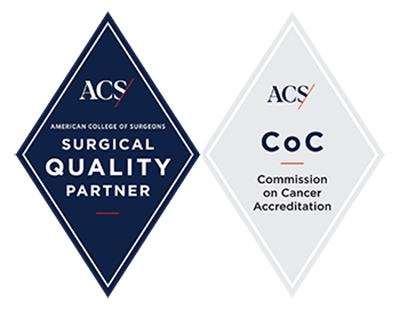Axillary Lymph Node Dissection for Breast Cancer
Breast cancer can spread beyond the breast where it originated to other tissues and organs. Typically, the first tissues affected are lymph nodes in the armpit (axillary lymph nodes), which filter lymph as it drains from the breast. For this reason, breast cancer staging often involves removing one or more axillary lymph nodes for microscopic examination by a pathologist, who can identify cancerous cells.
Two main types of lymph node surgery may be performed as part of the breast cancer staging process: sentinel lymph node mapping and biopsy, which involves removing the lymph nodes closest to the primary tumor site (sentinel nodes), and axillary lymph node dissection, which involves removing most or all of the axillary lymph nodes. Lymph node surgery can help a physician stage a breast tumor and plan treatment. Additionally, removing cancerous lymph nodes can reduce the risk of recurrence and improve the prognosis.

Why is axillary lymph node dissection performed?
Axillary lymph node dissection may be considered if enlarged axillary lymph nodes are found during a physical examination or if the sentinel nodes test positive for cancer in sentinel node mapping and biopsy. Additionally, the procedure is often performed during breast cancer surgery, such as mastectomy, to check for lymph node involvement.
Who is a good candidate for axillary lymph node dissection?
A good candidate for axillary lymph node dissection has evidence of breast cancer spread to the axillary lymph nodes, which may be detected in a physical examination, imaging test or sentinel lymph node mapping and biopsy. Overall, the decision to perform the procedure will be based on individual factors, such as the type, stage and characteristics of the breast tumor.
How to prepare for axillary lymph node dissection
To prepare for axillary lymph node dissection, the patient should:
- Undergo all recommended preoperative evaluations, such as blood work and imaging tests
- Participate in a preoperative consultation with the surgical team to learn about the procedure, anesthesia and expected recovery
- Discuss their current medications with the surgical team and make any necessary adjustments, such as temporarily stopping blood thinners before the procedure
- Follow the surgeon’s fasting guidelines, which usually start the night before surgery
- Make appropriate lifestyle modifications, such as quitting smoking and consuming a healthier diet
- Arrange for post-surgical support at home
What happens during axillary lymph node dissection?
Axillary lymph node dissection usually involves:
- Anesthesia – The patient will receive general anesthesia to ensure they remain asleep during the procedure.
- Incision – The surgeon will make an incision across the armpit.
- Lymph node removal – The surgeon will remove the pad of fat from the hollow of the armpit, which usually contains most or all of the axillary lymph nodes.
- Pathological examination – In a lab, a pathologist will cut each removed lymph node in half, prepare slides and examine the tissue under a microscope to check for cancerous cells.
What are the risks and possible complications of axillary lymph node dissection?
While generally safe and effective, axillary lymph node dissection carries several risks and potential complications, which usually can be managed with proper care. These include infection at the surgical site, swelling (lymphedema) and temporary or permanent numbness in the upper arm. Some patients also experience fluid accumulation (seroma) that requires drainage. Additionally, there may be minor bleeding or bruising, and, less commonly, restricted shoulder movement. The surgical team will take appropriate precautions to minimize these risks and provide guidance on postoperative care.
ACS Surgical Quality Partner for 30+ Years
Continuously Accredited by the American College of Surgeons Commission on Cancer since 1989 for our commitment to providing comprehensive, high-quality and multispecialty patient-centered care.
What to expect during recovery from axillary lymph node dissection
After axillary lymph node dissection, the patient can expect a period of rest and monitoring in the hospital, typically involving an overnight stay. Any discomfort can usually be managed with prescribed pain medications. Initially, the patient may have a drain in place to remove excess fluid, which will be removed within a week. Swelling and limited arm movement are common, and physical therapy can help prevent stiffness and restore range of motion. It will be important for the patient to follow the surgeon’s postoperative instructions regarding incision care and activity restrictions. This can help ensure proper healing and minimize the risk of complications.
How effective is axillary lymph node dissection?
Axillary lymph node dissection can be effective for staging breast cancer and determining the extent of its spread. This valuable prognostic information can influence the choice of further treatment, such as chemotherapy or radiation therapy. Significantly, studies show that the breast cancer recurrence rate is less than 5% after axillary lymph node dissection.
Benefit from world-class care at Moffitt Cancer Center
Moffitt offers a comprehensive range of innovative breast cancer diagnostic and treatment services—including a robust portfolio of clinical trials—in a single location. Our board-certified, fellowship-trained breast surgeons consistently achieve highly successful surgical outcomes, which contribute to our 95% rating in patient satisfaction.
If you would like to learn more about axillary lymph node dissection, you can request an appointment with a specialist in Moffitt’s renowned Don & Erika Wallace Comprehensive Breast Program by calling 1-888-663-3488 or submitting a new patient registration form online. We do not require referrals.

